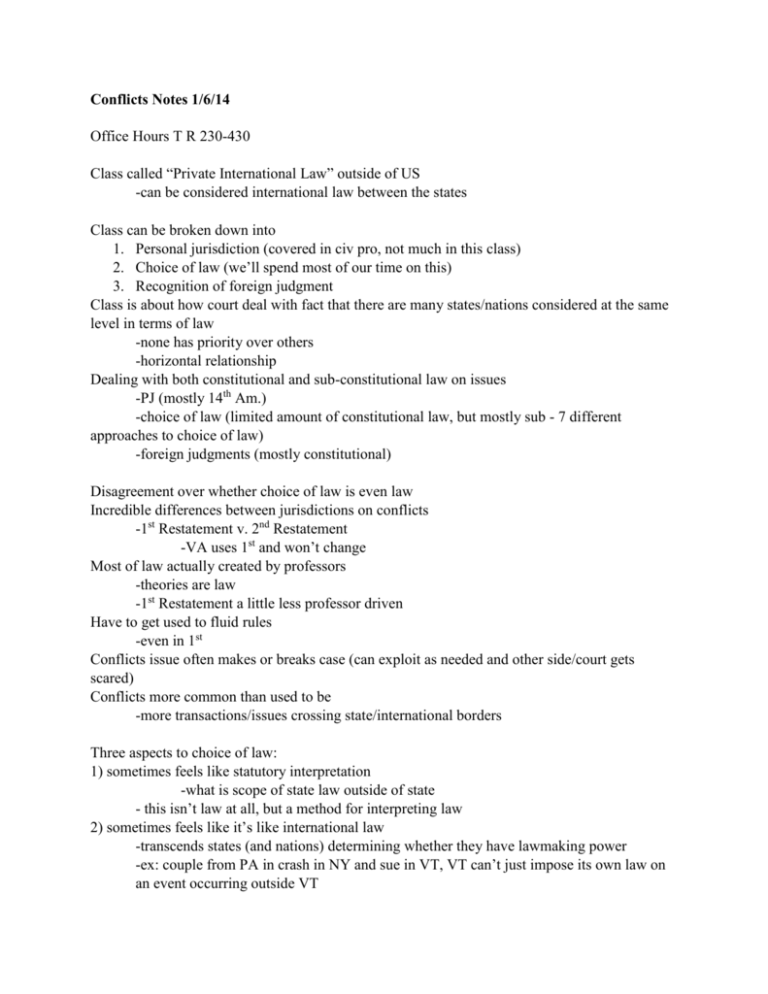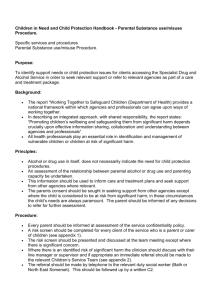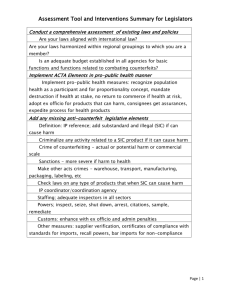Notes
advertisement

Conflicts Notes 1/6/14 Office Hours T R 230-430 Class called “Private International Law” outside of US -can be considered international law between the states Class can be broken down into 1. Personal jurisdiction (covered in civ pro, not much in this class) 2. Choice of law (we’ll spend most of our time on this) 3. Recognition of foreign judgment Class is about how court deal with fact that there are many states/nations considered at the same level in terms of law -none has priority over others -horizontal relationship Dealing with both constitutional and sub-constitutional law on issues -PJ (mostly 14th Am.) -choice of law (limited amount of constitutional law, but mostly sub - 7 different approaches to choice of law) -foreign judgments (mostly constitutional) Disagreement over whether choice of law is even law Incredible differences between jurisdictions on conflicts -1st Restatement v. 2nd Restatement -VA uses 1st and won’t change Most of law actually created by professors -theories are law -1st Restatement a little less professor driven Have to get used to fluid rules -even in 1st Conflicts issue often makes or breaks case (can exploit as needed and other side/court gets scared) Conflicts more common than used to be -more transactions/issues crossing state/international borders Three aspects to choice of law: 1) sometimes feels like statutory interpretation -what is scope of state law outside of state - this isn’t law at all, but a method for interpreting law 2) sometimes feels like it’s like international law -transcends states (and nations) determining whether they have lawmaking power -ex: couple from PA in crash in NY and sue in VT, VT can’t just impose its own law on an event occurring outside VT -beyond VT power to legislate outside of state - here it is like law, but not the law of any particular jurisdiction 3) sometimes feels like it’s procedure - rules a court has for choosing between states’ laws -VT would use VT choice of law rules to determine whether NY or PA law applies (because procedural) Traditional Approach 10 jurisdictions still use -holdouts are REALLY holding out (none likely to flip to Modern anytime soon) Carroll -harm in MS -sued in AL (forum state) -negligence in AL by fellow employee -suing employer -both sides of v domiciled in AL -under common law, can’t sue corp for neg of fellow employee -MS follows common law -AL has statute allowing action Court says MS law applies Fellow servant rule -applies based on place of harm (place of wrong law determines whether there is a fellow servant rule) -look to MS to determine if tort against employer (since MS place of harm) Metaphysical argument that has to be this way -can’t have tort w/o harm, so last piece of the puzzle used for conflict -injury beyond AL borders, so unfair AL can affect things in MS -argument ultimately doesn’t make sense because negligence in AL just as necessary as harm in MS to there being a tort -means MS gets to affect actions in AL borders In addition to metaphysical argument (or international law argument) about scope of state power, AL Supreme Court engages in statutory interpretation -legislature likely thought it was limited to AL harm when writing statute -taking into account conflicts law of the time - AL COULD exert power if it wanted, eg if statute said that it applied to out of state harm 1st Restatement almost always looks to place of harm What if fell in MS, but first feels harm in LA (eg arm falls off)? -some damages still happen in MS (even if biggest harm felt in LA), so apply MS law -look to smallest harm possible Poisoned in AL, sick in MS, dies in LA -MS (first place where poison manifests itself) -under common law, can’t sue for poisoning alone Problem: What is a harm is a legal question. Need to know what law applies to determine where place of injury occurs -for instance, what happens in AL says mental anguish from being poisoned alone is cognizable injury? -especially difficult for contracts -choose place of contracting, but what constitutes acceptance is itself a legal question 1st Restatement ignores these issues by using the common law approach of place of (physical) harm - That place determines whether there is a tort Place of ORIGINAL wrong governs wrongful death (eg decedent dies in MS) -even if spouse lives in AL and loss of consortium happens there, MS law applies to survival action Fraud, harm occurs where P parted with the goods -so, D speaks over the phone in LA to P in AL, commits fraud, P sends goods to D from AL, D refuses to return in LA, AL law applies (where P parted with goods) Acts of omission governed by domicile of P when harm occurred -by fraud, D convinces P to not sell stock and harm occurs, Ps domicile at time of fraudulent statements used (otherwise, too difficult to tell when harm actually occurred) Defamation, all places where reputation harmed -can be in multiple jurisdictions -where D communicated to - but sometimes courts will use law of P’s domicile, on theory that that is where the reputation harm is the greatest D lives in MA, dog wanders into NH and bites P -MA has one-free-bite rule, NH has strict liability -harm in NH, so NH law applies Place of wrong determines -whether damages recognized -limitations on damages (eg are punitives allowed) -standard of care -whether contributory or comparative negligence governs -even if P negligence occurs in another jurisdiction





